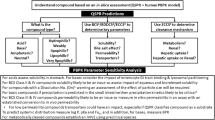Summary
A model-independent method for calculation of the absorption rate based on an exact mathematical solution to the deconvolution problem of systems with linear pharmacokinetics and a polyexponential impulse responses has been examined. Theoretical analysis shows how a noninteracting primary input can be precisely evaluated when data on blood levels from a known source such as an i.v. bolus or zero-order infusion are available. This work compares the use of a Lagrange 3rd degree polynomial with that of a cubic spline function (special 3rd degree polynomial) for calculation of the absorption rate. The method is compared to another using simulated data (12 data points) containing various degrees of random noise. The accuracy of the methods is determined by how well the estimates represent the true values. It was found that the accuracy of the two methods was not significantly different, and that it was of the same order of magnitude as the noise level of the data.
Similar content being viewed by others
Rererences
Schall R., Luus H.G. (1991):Comparison of absorption rates in bioequivalence studies of immediate release drug formulations. Int. J. Clin. Pharmacol. Ther. Toxicol., 30, 153–159.
Chen M.L. (1992):Alternative approach for the assessment of rate of absorption in bioequivalence studies. Pharm. Res., 9, 1380–1385.
Bois F.Y., Tozer T.N., Hauck W.W., Chen M.L., Patnaik R., Williams R.L. (1994):Bioequivalence performance of several measures of rate of absorption.Pharm. Res., 11, 966–974.
Herchuelz A. (1996):Bioequivalence assessment and the conduct of bioequivalence trials: a European point of view. Eur. J. Drug Metab. Pharmacokinet., 21, 149–152.
Godbillon J., Cardot J.M., Lecaillon J.B., Lefevre G., Sioufi A. (1996):Bioequivalence assessment: a pharmaceutical industry perspective. Eur. J. Drug Metab. Pharmacokinet., 21, 153–158.
Patnaik R., Lesko L.J., Chan K., Williams R.L. (1996):Bioequivalence assessment of generic drugs: an American point of view. Eur. J. Drug Metab. Pharmacokinet., 21, 159–164.
Pedersen V.P. (1980):Model-independent method of analyzing input in linear pharmacokinetic systems having polyexponential impulse response I: theoretical analysis. J. Pharm. Sci., 69, 298–304.
Popović J., Popović V. (1993):Analysis of toxicokinetic data by means of spline functons. Arch. Toxicol. Kin. Xen. Metab., 1, 79–93.
Author information
Authors and Affiliations
Rights and permissions
About this article
Cite this article
Popović, J. Cubic spline functions and polynomials for calculation of absorption rate. Eur. J. Drug Metab. Pharmacokinet. 23, 469–473 (1998). https://doi.org/10.1007/BF03189997
Issue Date:
DOI: https://doi.org/10.1007/BF03189997




